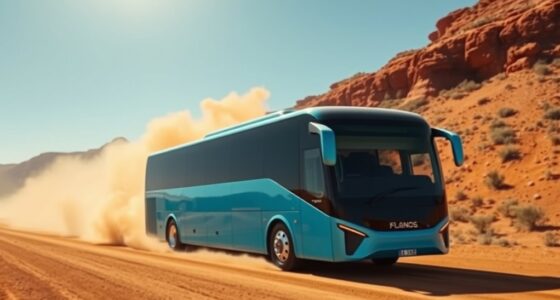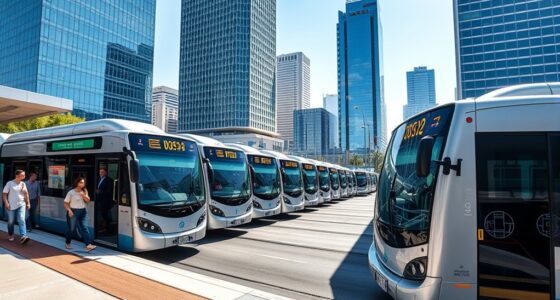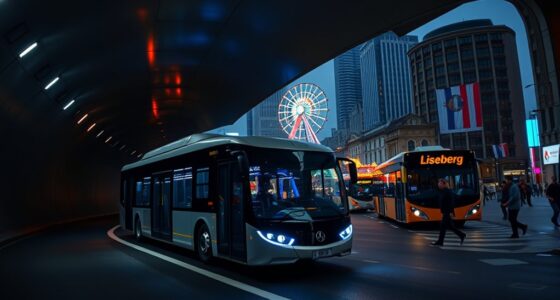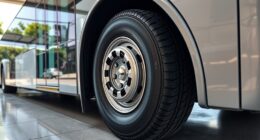Implementing electric buses in developing countries involves balancing higher upfront costs with long-term savings on fuel and maintenance. You’ll need to plan for charging infrastructure, which is often overlooked but essential for reliable service. Strategic funding, incentives, and technological advances can support adoption despite budget constraints. Successful projects like Senegal’s BRT show it’s possible, but careful coordination and planning are key. Keep exploring to discover how these challenges are effectively addressed.
Key Takeaways
- Securing funding and incentives is crucial to offset high initial costs of electric buses in developing countries.
- Developing adequate charging infrastructure is essential for reliable electric bus operations.
- Strategic planning should integrate procurement with infrastructure deployment to ensure smooth implementation.
- Retrofitting existing buses and adopting fast-charging solutions can reduce costs and improve efficiency.
- Successful examples, like Senegal’s BRT and China’s extensive networks, demonstrate effective implementation strategies.
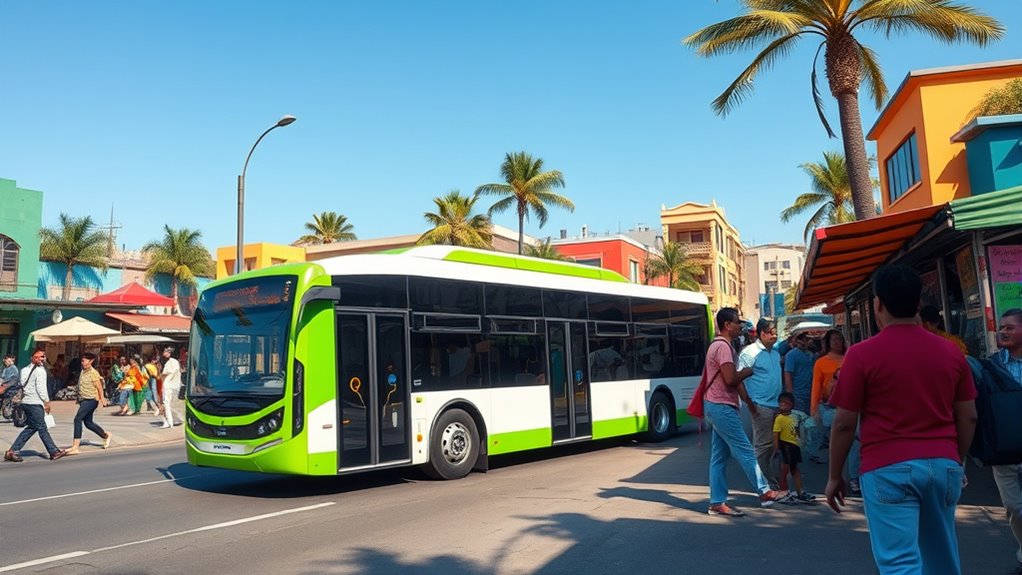
Are electric buses the future of public transportation in developing countries? That’s a question many are asking as cities seek sustainable solutions amid mounting pollution and climate concerns. While electric buses offer promising environmental benefits, their implementation faces notable hurdles.
Are electric buses a sustainable solution for developing countries’ urban transport challenges?
The most notable challenge is cost. Electric buses can be nearly 60% more expensive than traditional internal combustion engine (ICE) vehicles, making upfront investments difficult for developing nations with limited budgets. This higher initial price tag can slow adoption, especially when budgets are tight. However, it’s important to consider that operational costs tend to be lower over time. Electric buses consume less energy, have fewer moving parts, and require less maintenance, which can offset the initial expense in the long run. Additionally, project planning plays a vital role in ensuring the successful deployment of electric bus fleets by optimizing resource allocation and infrastructure development.
Infrastructure development is another essential obstacle. Many projects focus on procurement, but neglect the need for charging stations and supporting infrastructure. Without proper facilities, deploying electric buses, especially in rural areas, becomes complex. Inadequate charging infrastructure can lead to logistical issues, reducing the reliability and efficiency of electric fleets. Developing charging infrastructure is critical to overcoming these logistical challenges and ensuring operational consistency. Moreover, advancements in battery technologies are continuously improving the range and charging times of electric buses, which enhances feasibility.
Strategic planning is fundamental to integrate new technology into existing transport systems smoothly. This involves coordinating vehicle procurement with infrastructure rollout to ensure buses are charged and ready for service.
From an economic perspective, governments and organizations like the World Bank can offer critical support through funding and technical assistance. These investments help offset the higher upfront costs and encourage local employment by developing local manufacturing and maintenance industries.
Incentives from governments also play a pivotal role, making electric buses more financially accessible. These incentives can include tax breaks, grants, or subsidies, helping to accelerate adoption.
The environmental advantages of electric buses are compelling. They can substantially reduce greenhouse gas emissions, which is essential for climate change mitigation. Replacing traditional diesel-powered buses improves urban air quality and aligns with broader sustainable transport goals.
Electric buses are more resource-efficient, consuming less energy and producing fewer pollutants during operation, which benefits public health and the environment.
Successful case studies demonstrate the feasibility of electric bus adoption. Senegal’s Bus Rapid Transit system operates entirely with electric buses, cutting emissions and reducing travel times. Fiji is exploring electric corridors, while China leads globally with extensive electric bus networks.
Support from the World Bank and regional collaborations further bolster these efforts, helping countries share knowledge and resources.
Technological advances also aid implementation. Retrofitting existing buses with electric systems can be more cost-effective than buying new ones, and developing fast-charging solutions is essential for operational efficiency.
While challenges remain, the combination of economic incentives, technological progress, and environmental necessity makes electric buses a promising step toward sustainable urban mobility in developing countries.
Frequently Asked Questions
What Are the Primary Challenges Faced During Electric Bus Deployment?
You face several challenges when deploying electric buses. Limited grid capacity and a lack of charging stations make it hard to keep buses running smoothly.
High upfront costs and scarce funding slow down adoption. Weak policies and infrastructure upgrades are necessary but often overlooked.
You also need trained staff and better management systems. Overcoming these issues requires innovative solutions, strategic planning, and strong support from government and private sectors.
How Do Electric Buses Impact Urban Air Quality Long-Term?
You wonder how electric buses impact urban air quality long-term. As you switch to electric, you reduce emissions of nitrogen oxides and particulate matter, leading to cleaner air.
Over time, these buses help lower pollution levels, improve public health, and create healthier urban environments. Your city becomes more livable, with less smog and respiratory issues, demonstrating that investing in electric buses benefits everyone’s health and the planet in the long run.
What Financing Options Are Available for Developing Countries?
You can explore various financing options to fund electric bus projects in developing countries. International institutions like the World Bank, IFC, and AIIB provide loans, grants, and targeted investments.
Governments also offer subsidies, incentives, and develop infrastructure.
Innovative models like green bonds, impact investing, and blended finance attract private sector participation.
Public-private partnerships, leasing schemes, and risk mitigation tools further support affordable and sustainable electric bus adoption.
How Do Electric Buses Compare Cost-Wise to Diesel Buses?
You might think diesel buses are cheaper, but electric buses are the real game-changer. While they cost about 50% more upfront, their operational savings are massive—they use electricity, which is way cheaper than diesel, and need less maintenance.
Over 12 years, you could save up to $173,000 per bus. Plus, they cut emissions dramatically, making them not just a cost choice but an environmental breakthrough.
What Training Is Necessary for Maintenance Crews?
You need to guarantee maintenance crews are trained in preventive practices like monitoring battery health and thermal management. They should learn diagnostic software for troubleshooting BMS and onboard electronics.
Hands-on skills are essential for component replacements—batteries, inverters, motors—and high-voltage safety protocols.
Additionally, crews must understand data-driven scheduling, fleet management software, and real-time monitoring systems.
This exhaustive training ensures safe, efficient upkeep of electric buses, maximizing performance and longevity.
Conclusion
As you consider the future of transportation in developing countries, remember that electric buses are the keys to opening cleaner air and sustainable cities. Think of this shift as planting seeds for a greener tomorrow—each bus powered by electricity helps clear the smog and breathe life into communities. Embracing this change isn’t just about technology; it’s about creating a brighter, healthier future where progress and the environment walk hand in hand.


